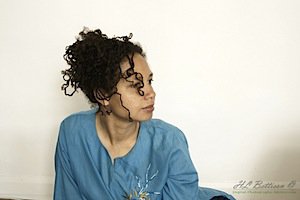

Has buying the right studio lighting setup stopped you from taking your portrait photography seriously? It shouldn’t. You can take great portraits with natural light.
Photography is about light. Learning how to see light is essential to developing your photographic eye. When taking pictures, being able to determine the intensity, color and direction of the light will help you know how to position your subject and which camera settings to use.
Intensity of Light
Direct intense light can be quite harsh. You often find these conditions on bright sunny days. Harsh light intensifies the contrast between light and shadows and can be very unflattering. When you take pictures in harsh sunlight your subject often ends up with shadowy eye sockets that make them look tired.
When working with diffused less intense light, contrast is lower and the light is more flattering. When the sun is shining brightly overhead there are a few things you can do to diffuse the light.
Find some cover. Shade can act as a great diffuser. Try to photograph your subject under the cover of a porch, awning, or the shade of tree cover. When working in shade make sure the subject is evenly covered by the shade. Any specks of bright sunlight shining on them will detract from the look of the picture.
If you don’t have any shade in the area, you can diffuse the light with a scrim. Simply place the scrim between your subject and the light source.
Overcast days are good for natural light portrait photography because the cloud cover acts as a natural diffuser. Even on overcast days you may find yourself in need of a fill flash to help your subject’s features stand out in the picture.
If you are taking pictures inside and relying on a window as your light source, move your subject away from the window to lessen the intensity of the light. You can also cover the window with sheer curtains or use a scrim between your subject and the window to help diffuse the light.
Color of Light
Some light is cool and has more of a bluish tint. Some light is warm and has more of a golden tint. Our eyes naturally adjust to changes in the color of light to keep colors looking the same in various lighting situations. Our cameras don’t do that. That’s why white balance is so important. When working with natural light you can use the white balance setting that is appropriate to the type of light your working with, like sunny, shade, or cloudy for example.
These white balance choices may not always give you the correct color in the picture though. The color of the objects the light reflects off of will influence the color of the light. If the color on your picture is not right it can make your subjectís skin look sickly. The best white balance results can be found when you use your custom white balance. Keep a gray card in your camera bag so you can set your custom white balance at every shoot. You can buy a gray card at any camera store.
 Direction
Direction
Knowing where the light is coming from will help you know where to position your subject to get the best picture. It’s natural to assume that the best way to position your subject is with the sunlight shining directly into the face to light up their features. This isn’t usually the best choice. Looking towards the sun will make your subject squint. It will also cause shadows around the eyes that make them tired. Instead, try positioning your subject with the sun behind them. The backlight this provides will cast nice highlights around the hair. With the sun behind them, use a reflector or a fill flash to fill in the shadows and light up the face for the picture. Another good option is to place your subject with the sun to the side and slightly behind them.
If you have a hard time determining where to place your subject in relation to the light source, try this exercise to help you see where the light is falling. Position your subject in the area where you want to photograph them. Stand as far away from them as you plan to be when you take the picture. Now walk completely around your subject noticing the light from all angles. Once you’ve walked around them once, walk a circle around them again slowly. This time have your subject turn with you so they are facing you the entire time. Look at their face closely and notice the changes in light as they face different directions. Notice how the light touches their features and where the shadows land. Notice how the light catches their eyes in each position. Once you find the best direction for your subject to face, take your pictures.
Learning to see light will take time. As you recognize the qualities of light, positioning your subject in the best light will become easier and easier.
YOU MIGHT ALSO LIKE










